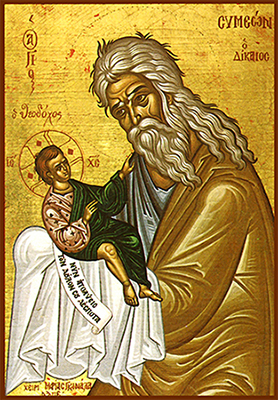The Main Figures in the Feast
The Main Figures in the Feast
The Child Jesus:
The child in the arms of Symeon is God the Creator who became a human being.
Tell us, O Symeon: Whom dost thou bear into the temple in thine arms, rejoicing? To Whom dost thou cry ![]() aloud: "Now have I been freed, for I have beheld my Savior!"? "He Who is born of the Virgin! God the Word, Who from God assumed flesh for our sake, thus saving mankind! Him let us worship!"
aloud: "Now have I been freed, for I have beheld my Savior!"? "He Who is born of the Virgin! God the Word, Who from God assumed flesh for our sake, thus saving mankind! Him let us worship!"
In the Hebrew language, the name “Jesus” or “Yahshua” means “God saves”. It is composed of two words: YAHWEH, which means “the Being” for it derives from the Hebrew verb to be, "hayá" הָיָה and Yesha יֶשַׁע which means” to save”.
The Greek for “Jesus” is “Ἰησοῦς”; from it derives the Arabic name (Issa).
In Latin, the name of Jesus is “IESVS”, which stayed in this way. The English word Jesus comes from the Latin and its derivatives.
The Virgin Mary Mother of God:
About the name Mary:
This name has roots in the ancient Egyptian language where mr means "beloved".
In the Hebrew language, it has various meanings that emerge from certain situations, such as the desire to have a son (“whished-for- child) and the cruelty of the Pharaoh over the Hebrew people during the days of Moses (“a sea of bitterness”) and "rebellion" or "disobedience". It is from the bitterness of Pharaoh that the name Miriam, the sister of Moses, appeared when the Hebrews were in Egypt.
Linguistics of ancient languages unanimously agreed upon the Egyptian root. From there on, this name passed to all languages, either in the form of “Maryam” or by translating its meaning: Lady. For example, in Italian we see the name La Madonna, which refers to the Mother of God, meaning "my lady".
In the Arabic tradition, which comes from the Egyptian-Hebrew, we call Mary "Our Lady" and "Our Lady the Virgin".
Here we impart a nice piece of information: this old root generated the Syriac "Mar" and "Mor", still used for the saints “Mar” and for Patriarchs. The Arabic and Turkish Merhaba is also derived from it and means: Love of the Lord.
Who is Mary?
The Virgin Mary is the daughter of Joachim and Anna of Nazareth, from the tribe of Judah.![]()
We find the story of her childhood in the “The First Gospel of James”, an apocryphal book which is cited by many saints of the Church.
Mary entered the temple at the age of three, because her parents dedicated her to the Lord, and there she was fed by angels. At the age of twelve, the priests deliberated and decided to hand her to someone who would preserve her, for it was forbidden to keep her in the temple after this age.
The high priest prayed to God for guidance. Then an angel appeared to him and asked him to gather the righteous widowers so that she would be handed to one of them. The Lord indicated Joseph the Carpenter as the guardian of Mary.
Veneration to the Mother of God
She is the Most-Holy (Panaghia) and the Mother of God (Theotokos) a title established by the Third Ecumenical Council. This is evident in the Gospel of Luke, as Elizabeth calls her "the Mother of my Lord" (Mitir to Kiriou)
The Gospel of Luke relates the Annunciation and how God called Mary through the angel “full of grace” and “blessed among women”, saying that the Spirit of God has come upon her.
However, this does not mean that we worship her at all; we rather honor her. Worship is for the Lord Jesus Christ, son of God.
In addition to the Annunciation, there are biblical events that highlight the importance of the Virgin Mary.
Events about the Nativity of Christ.
- Her visit to Elizabeth, who said: " But why is this granted to me, that the mother of my Lord should come to me?" (Luke 1:43)
- The Presentation of the Lord to the Temple.
- The wedding in Cana of Galilee, when she informed to master of the feast that there was no wine and said to the servants: Do all that he asks of you.
- At the Cross.
Feast days of the Virgin Mary Mother of God
The Orthodox Church preserves a special place for the Mother of God in the liturgical worship and the life of the faithful.
It must be noted here that the Virgin Mary is honored originally for being the Mother of the Savior. Although the feasts that celebrate her show veneration, they are directly related to the Lord Jesus Christ and are called Feasts of the Lord because they revolve around the economy wrought by God for our salvation.
It is worth noting that the Nativity of the Mother of God (September 8), falls at the beginning of the Orthodox ecclesiastical year (September 1) and her Dormition falls at the end of the ecclesiastical year (August 15).
The Mother of God is celebrated on many other feasts, mainly: her Presentation to the Temple (November 21); her Annunciation (March 25); her Synaxis on December 26 -the day following Nativity; the Placing of her Belt (August 31) and then of her Robe (July 2); the Spring of Life, on Friday of the Bright week, i.e. the week after Pascha.
We also invoke the Theotokos in all daily prayers, in the Divine Liturgy, as well as in the Supplication Service (Paraclisis), and the Acathist Hymn during Great Lent.
Joseph the Betrothed
Joseph is a Hebrew name, meaning: God gives abundantly, God increases.
![]() He is the son of Matthan according to the Gospel of Matthew (16:1), and the son of Heli in the Gospel of Luke (3:23). The difference is due to the fact that Saint Luke mentions the lineage of Joseph according to nature while St. Luke cites his descendance according to the law. However, both are related to the king's David. Had the kingdom continued in Israel, Joseph the Betrothed would have become the legal heir to the throne of Judah.
He is the son of Matthan according to the Gospel of Matthew (16:1), and the son of Heli in the Gospel of Luke (3:23). The difference is due to the fact that Saint Luke mentions the lineage of Joseph according to nature while St. Luke cites his descendance according to the law. However, both are related to the king's David. Had the kingdom continued in Israel, Joseph the Betrothed would have become the legal heir to the throne of Judah.
In the biblical and apocryphal tradition, Joseph was a widower with children. Mary was entrusted to him after the High Priest had gathered the widowers of the Jews and prayed on their rods. He was seeking a sign to choose someone who would protect the Virgin Mary. When a dove came and settled on Joseph's rod, priest Zacharias handed Mary over to Joseph.
After the Annunciation (Luke 26: 1), when Mary returned to Nazareth from her visit to her aunt Elisabeth, Joseph found her pregnant and was confused. However, he was unwilling to disgrace her publicly and resolved to divorce her quietly.
However, an angel appeared to him and said: “Joseph, son of David, do not be afraid to embrace Mary as your wife, for the One conceived in her is from the Holy Spirit” (Matthew 1:20).
Indeed, Joseph was a righteous man. “Then Joseph, being aroused from sleep, did as the angel of the Lord commanded him and took to him his wife, and did not know her till she had brought forth her firstborn Son. And he called His name Jesus” (Matthew 1:25).
He continued to accompany the Mother of God and the divine Child, suffering hardships and travel difficulties (they went to Egypt and stayed there for almost three years, then they returned after Herod's death. He listened fully to the will of the Lord, as the angel of the Lord spoke to him continuously and guided his path. (Matthew, chapter 2)
Joseph witnessed the events of the shepherds and the Magi, and heard the prayers and rejoicing of old Symeon and Anna, the daughter of Phanuel (Luke 2:25-38)
Joseph the righteous is mentioned in the Gospels for the last time when he was with the Mother of God and the Lord Jesus, in Jerusalem. At a certain point, they lost Jesus then they found Him among the scholars in the temple. Jesus was at the age of twelve. (Luke 2:46).
The Solemnity of St. Joseph the Righteous in the Orthodox Church is on the Sunday after Nativity.
The Holy and Righteous Symeon the God-receiver, and the Holy Anna The Prophetess
“The divinely inspired Anna and the most venerable Symeon, resplendent in prophecy, manifest as blameless according to the law, beholding the Bestower of the law manifest among us as a Babe, have now worshipped Him. We now joyously celebrate their memory, glorifying as is meet, Jesus Who is the Lover of mankind”.
This is how the liturgical service describes the saints. They were righteous and had a spirit of prophecy, so they saw the Giver of the Law as a child.
Symeon:
This name derives from Hebrew “Shim‛ôn” (Ancient Greek: Símōn “Σῐ́μων”), meaning “He (God) has heard”. In turn, it derives from the word “sh' ma”, meaning “listen” (God has heard your prayer to grant a child; cf. Genesis 29:32-33).
One should mention here that names in Semitic cultures express the identity or expectations of the persons that bear them. 
Sh'ma Yisrael are the first two words of a prayer that serves as a centerpiece of the morning and evening Jewish prayers. Hence, Symeon is also the model of the man of prayer who listens to God’s word and awaits His salvation. As he bears the Lord Jesus on his shoulders, his name expresses thanksgiving and praise when he sees the Lord Creator.
The peak of Symeon’s joy is expressed in his words which we repeat in our daily vespers service:
“Lord, now You are letting Your servant depart in peace,
According to Your word;
For my eyes have seen Your salvation
Which You have prepared before the face of all peoples,
A light to bring revelation to the Gentiles,
And the glory of Your people Israel.”(Luke 2:32).
Old Symeon no longer cares about death, but rather says, "My heart is ready, O God." As he sees and holds in his arms the God incarnate, he fathoms eternal life and true peace. Hence, he now calls us to bear the Lord on our arms and enter into the temples of our hearts and souls into a new creation.
People wonder about the identity of the Symeon: who is he?
In the liturgical service and the icon, Symeon is described as an elderly man. Perhaps the verses “that he will not see death before he sees the Lord’s Christ” and what follows led to that conclusion (Luke 2:26).
- People said that it was Symeon who rebuked Archelaus, the successor of great Herod who also married his brother's widow.
- Others say that he is rather the son of Hillel and the father of Gamaliel. This Gamaliel is mentioned in the book of Acts as the teacher of Saint Paul (Acts 3:22) into Pharisaic doctrine. This hypothesis reports that he was the head of the Sanhedrin in 13 AD.
Another opinion believes that Symeon was one of the seventy scholars of Alexandria, who translated the Old Testament from the original Hebrew into Greek. As he translated the book of Isaiah, he reached the verse: "Behold, the virgin will conceive and she will bear a son and will call his name Emmanuel" (7:14). Realizing that a pregnant woman cannot be named a virgin, he wanted to erase the word and replace it with "lady". When he returned the next day, he found the word "girl" erased and the word "virgin" in its place. So he realized that there is nothing impossible to God. Then it was revealed to him that he would not die before seeing the Christ of the Lord.
The old Symeon is a very important person in Jewish history:
According to the Apocryphal “Gospel of Matthew”, he was 112 years old when he received the Lord Jesus Christ in his arms. As for the Proto-gospel of James, it claims that he was elected to replace Zechariah the priest, even though the gospel does not mention any connection to the priesthood, but only says: “And behold, there was a man in Jerusalem whose name was Symeon, and this man was just and devout, waiting for the Consolation of Israel” (Luke 2:25).
Perhaps this is why some call Symeon the “watchman of the morning”, as in Psalm 129: “I wait for the Lord, my soul waits, and in His word I do hope. My soul waits for the Lord more than those who watch for the morning (5-8). This is also related to the meaning of the name Symeon.
Some Fathers of the Church say that he is the great son of the Scholar Hillel, who established a school and was the head of the Sanhedrin for forty years. They also say he is the father of Scholar Gamaliel, the teacher of the Apostle Paul when he was Saul.
They rely on Rabbinic texts: "Jesus of Nazareth was born in Bethlehem in the year 3761 of the creation, and he was in the year 42 of August Caesar, and his birth was in the last days of the Rabbi Symeon Son of Hillel." This means that he is a great and elderly leader.
Whatever the case, scholars believe that Symeon fell asleep shortly after seeing Christ the Lord. His relics were honored in Constantinople in the church of St. James, in the 6th century AD, under Emperor Justin.
Anne:
- meaning of the name
The name Anna is a Hebrew name derived from the verb “Shana", which denotes affection, mercy, and grace. All of these names: Anna, Ananias, and John are from the same root and all indicate that Yahweh is compassionate, God is merciful.
- Anna, the daughter of Phanuel, from the tribe of Asher.![]()
Asher is one of the children of Jacob who formed the tribes of Israel. The word tribe means "rod", meaning a group led by a chief holding a pastoral and discipline rod. The tribes are twelve in number (according to the order of birth): 1- Reuben, 2- Shimon, 3- Levi (sorted for priestly service), 4- Judah, 5- Dan, 6- Naphtali, 7- Gad, 8- Asher, 9- Issachar, 10-Zebulun, 11-Yusef (Son of Manasseh and Ephraim), 12-Benjamin.
A Widower and Prophetess
Anna was very old, and she had lived with her husband for seven years, then she was widowed, and did not marry again. When she met the child Jesus, she was 84 years old. During this long period of her life, she did not depart from the temple, but rather remained praying and fasting day and night. She is an example of struggle and patience, “Whoever is patient to the end will be saved” (Matthew 22:10). Her advanced age was not an impediment, quite the opposite, even though she was old in the body, her soul was vivid while waited for the salvation of the Lord. She is, therefore, a model for widows, virgins and monks who keep chastity and continue to fast and pray, in continuous worship, day and night.
After Anna saw the divine child on the arms of Symeon and heard Symeon’s confession, she stood praising the Lord and spoke about him to all those who were waiting for the Redemption in Jerusalem. (Luke 2:36-38).
Anna and Symeon are the model characters of the pious who live in prayer and to whom the Lord declares Himself and gives comfort.

2025-01-21
Consultative Meeting with the…
2025-01-21
Swedish Ambassador to Lebanon…
2025-01-20
Patriarch John X Meets Patriarch…
2025-01-19
Divine Liturgy at the…
2025-01-19







